Three-Dimensional Reconstruction Method for Machined Surface Topography Based on Gray Gradient Constraints
Abstract
Featured Application
Abstract
1. Introduction
2. Reconstruction Principle
2.1. Basic Principle of SFS
2.2. Analytic Reconstruction Principle
3. Implementation of Reconstruction Method
3.1. The Quantization Error of Gray Scale
3.2. The Ambiguous Gray Scale
3.3. Reconstruction Algorithm
4. Experiments
4.1. Experimental Results on Synthetic Images
4.2. Experimental Results on Machined Surface Topography Image
5. Conclusions
Author Contributions
Funding
Acknowledgments
Conflicts of Interest
References
- Zhang, X.; Zhang, W.; Zhang, J.; Pang, B.; Zhao, W. Systematic study of the prediction methods for machined surface topography and form error during milling process with flat-end cutter. Proc. Inst. Mech. Eng. Part B J. Eng. Manuf. 2017, 233, 226–242. [Google Scholar] [CrossRef]
- Krolczyk, G.M.; Maruda, R.W.; Krolczyk, J.B.; Nieslony, P.; Wojciechowski, S.; Legutko, S. Parametric and nonparametric description of the surface topography in the dry and MQCL cutting conditions. Measurement 2018, 121, 225–239. [Google Scholar] [CrossRef]
- Lesyk, D.A.; Martinez, S.; Mordyuk, B.N.; Dzhemelinskyi, V.V.; Lamikiz, A.; Prokopenko, G.I. Effects of laser heat treatment combined with ultrasonic impact treatment on the surface topography and hardness of carbon steel AISI 1045. Opt. Laser Technol. 2019, 111, 424–438. [Google Scholar] [CrossRef]
- Grobelny, P.; Furmanski, L.; Legutko, S. Investigations of Surface Topography of Hot Working Tool Steel Manufactured with the Use of 3D Print. MATEC Web Conf. 2017, 137, 02004. [Google Scholar] [CrossRef]
- Launhardt, M.; Wörz, A.; Loderer, A.; Laumer, T.; Drummer, D.; Hausotte, T.; Schmidt, M. Detecting surface roughness on SLS parts with various measuring techniques. Polym. Test. 2016, 53, 217–226. [Google Scholar] [CrossRef]
- Do Vale, J.L.; de Beltrão, V.C.; da Silva, C.H.; Pintaúde, G. Evaluation of the error of the light beam incidence on concave surfaces in 3D roughness parameters using optical interferometry. Measurement 2018, 120, 182–192. [Google Scholar] [CrossRef]
- Srivastava, M.; Hloch, S.; Krejci, L.; Chattopadhyaya, S.; Dixit, A.R.; Foldyna, J. Residual stress and surface properties of stainless steel welded joints induced by ultrasonic pulsed water jet peening. Measurement 2018, 127, 453–462. [Google Scholar] [CrossRef]
- Wang, S.; Wu, T.; Yang, L.; Kwok, N.; Sarkodie-Gyan, T. Three-dimensional reconstruction of wear particle surface based on photometric stereo. Measurement 2019, 133, 350–360. [Google Scholar] [CrossRef]
- Tang, J.; Qiu, Z.; Li, T. A novel measurement method and application for grinding wheel surface topography based on shape from focus. Measurement 2019, 133, 495–507. [Google Scholar] [CrossRef]
- Tang, S.; Zhang, X.; Song, Z.; Jiang, H.; Nie, L. Three-dimensional surface reconstruction via a robust binary shape-coded structured light method. Opt. Eng. 2017, 56, 014102. [Google Scholar] [CrossRef]
- Zhou, D.S.; Wang, R.; Lu, J.; Zhang, Q. Depth Image Super Resolution Based on Edge-Guided Method. Appl. Sci. 2018, 8, 298. [Google Scholar] [CrossRef]
- Jia, C.L.; Mi, S.B.; Barthel, J.; Wang, D.W.; Dunin-Borkowski, R.E.; Urban, K.W.; Thust, A. Determination of the 3D shape of a nanoscale crystal with atomic resolution from a single image. Nat. Mater. 2014, 13, 1044–1049. [Google Scholar] [CrossRef] [PubMed]
- Hu, J.-F.; Zheng, W.-S.; Xie, X.; Lai, J. Sparse transfer for facial shape-from-shading. Pattern Recognit. 2017, 68, 272–285. [Google Scholar] [CrossRef]
- Ma, L.; Lyu, Y.; Pei, X.; Hu, Y.M.; Sun, F.M. Scaled SFS method for Lambertian surface 3D measurement under point source lighting. Opt. Express 2018, 26, 14251. [Google Scholar] [CrossRef] [PubMed]
- Heise, B.; Stifter, D. Quantitative phase reconstruction for orthogonal-scanning differential phase-contrast optical coherence tomography. Opt. Lett. 2009, 34, 1306. [Google Scholar] [CrossRef] [PubMed]
- Maurer, D.; Ju, Y.C.; Breuß, M.; Bruhn, A. Combining shape from shading and stereo: A Joint variational method for estimating depth, illumination and albedo. Int. J. Comput. Vis. 2018, 126, 1342–1366. [Google Scholar] [CrossRef]
- Lu, S.; Ren, C.; Zhang, J.; Zhai, Q.; Liu, W. A novel approach to droplet’s 3D shape recovery based on mask R-CNN and improved Lambert–Phong model. Micromachines 2018, 9, 462. [Google Scholar] [CrossRef] [PubMed]
- Sun, W.; Chen, B.; Yao, B.; Cao, X.; Feng, W. Complex wavelet enhanced shape from shading transform for estimating surface roughness of milled mechanical components. J. Mech. Sci. Technol. 2017, 31, 823–833. [Google Scholar] [CrossRef]
- Zhu, A.; He, D.; Zhao, J.; Luo, W.; Chen, W. 3D Wear area reconstruction of grinding wheel by frequency-domain fusion. Int. J. Adv. Manuf. Technol. 2016, 88, 1111–1117. [Google Scholar] [CrossRef]
- Yang, L.; Li, E.; Long, T.; Fan, J.; Mao, Y.; Fang, Z.; Liang, Z. A welding quality detection method for arc welding robot based on 3D reconstruction with SFS algorithm. Int. J. Adv. Manuf. Technol. 2017, 94, 1209–1220. [Google Scholar] [CrossRef]
- Ozcelik, B.; Bayramoglu, M. The statistical modeling of surface roughness in high-speed flat end milling. Int. J. Mach. Tools Manuf. 2006, 46, 1395–1402. [Google Scholar] [CrossRef]
- Özel, T.; Karpat, Y. Predictive modeling of surface roughness and tool wear in hard turning using regression and neural networks. Int. J. Mach. Tools Manuf. 2005, 45, 467–479. [Google Scholar] [CrossRef]
- Ning, J.; Liang, S. Prediction of Temperature Distribution in Orthogonal Machining Based on the Mechanics of the Cutting Process Using a Constitutive Model. J. Manuf. Mater. Process. 2018, 2, 37. [Google Scholar] [CrossRef]
- Ning, J.; Liang, S. Predictive Modeling of Machining Temperatures with Force–Temperature Correlation Using Cutting Mechanics and Constitutive Relation. Materials 2019, 12, 284. [Google Scholar] [CrossRef] [PubMed]
- Ning, J.; Liang, S. Evaluation of an Analytical Model in the Prediction of Machining Temperature of AISI 1045 Steel and AISI 4340 Steel. J. Manuf. Mater. Process. 2018, 2, 74. [Google Scholar] [CrossRef]
- Ning, J.; Nguyen, V.; Liang, S.Y. Analytical modeling of machining forces of ultra-fine-grained titanium. Int. J. Adv. Manuf. Technol. 2018, 99, 1131–1140. [Google Scholar] [CrossRef]
- Ning, J.; Liang, S.Y. Model-driven determination of Johnson-Cook material constants using temperature and force measurements. Int. J. Adv. Manuf. Technol. 2018, 97, 1053–1060. [Google Scholar] [CrossRef]
- Ning, J.; Nguyen, V.; Huang, Y.; Hartwig, K.T.; Liang, S.Y. Inverse determination of Johnson–Cook model constants of ultra-fine-grained titanium based on chip formation model and iterative gradient search. Int. J. Adv. Manuf. Technol. 2018, 99, 1131–1140. [Google Scholar] [CrossRef]
- Tozza, S.; Falcone, M. Analysis and approximation of some shape-from-shading models for non-Lambertian surfaces. J. Math. Imaging Vis. 2016, 55, 153–178. [Google Scholar] [CrossRef]
- Alhulayil, M.; Younes, A.B.; Turner, J.D. Higher order algorithm for solving lambert’s problem. J. Astronaut. Sci. 2018, 65, 400–422. [Google Scholar] [CrossRef]
- Wang, G.; Cheng, J. Three-dimensional reconstruction of hybrid surfaces using perspective shape from shading. Optik 2016, 127, 7740–7751. [Google Scholar] [CrossRef]
- Lv, L.G. Vectors and coordinates. In Analytic Geometry; Higher Education Press: Beijing, China, 2011. [Google Scholar]
- Shi, W.C.; Zheng, J.M.; Li, Y.; Li, X.B.; An, Q.N. Measurement and modeling of bidirectional reflectance distribution function (BRDF) on cutting surface based on the coaxial optical microscopic imaging. Optik 2018, 170, 278–286. [Google Scholar] [CrossRef]
- Meng, Q.; Wang, H.; Xu, W.; Zhang, Q. A coupling method incorporating digital image processing and discrete element method for modeling of geomaterials. Eng. Comput. 2018, 35, 411–431. [Google Scholar] [CrossRef]
- Xu, J.; Wang, Z.; Tan, C.; Si, L.; Zhang, L.; Liu, X. Adaptive Wavelet Threshold Denoising Method for Machinery Sound Based on Improved Fruit Fly Optimization Algorithm. Appl. Sci. 2016, 6, 199. [Google Scholar] [CrossRef]
- Yi, H.A.; Liu, J.; Lu, E.H. Detection Method of Grinding Surface Roughness Based on Image Definition Evaluation. J. Mech. Eng. 2016, 52, 15–21. [Google Scholar] [CrossRef]
- Izquierdo, S.; López, C.I.; Valdés, J.R.; Miana, M.; Martínez, F.J.; Jiménez, M.A. Multiscale characterization of computational rough surfaces and their wear using self-affine principal profiles. Wear 2012, 274–275, 1–7. [Google Scholar] [CrossRef]
- Grzemba, B.; Pohrt, R.; Teidelt, E.; Popov, V.L. Maximum micro-slip in tangential contact of randomly rough self-affine surfaces. Wear 2014, 309, 256–258. [Google Scholar] [CrossRef]
- Bruvoll, S.; Reimers, M. Spherical surface parameterization for perspective shape from shading. Pattern Recognit. Lett. 2012, 33, 33–40. [Google Scholar] [CrossRef]
- Yang, L.; Zhang, N.; Ren, Y.; Hu, H. Linear perspective shape-from-shading method with two images. J. Syst. Eng. Electron. 2015, 26, 1080–1087. [Google Scholar] [CrossRef]
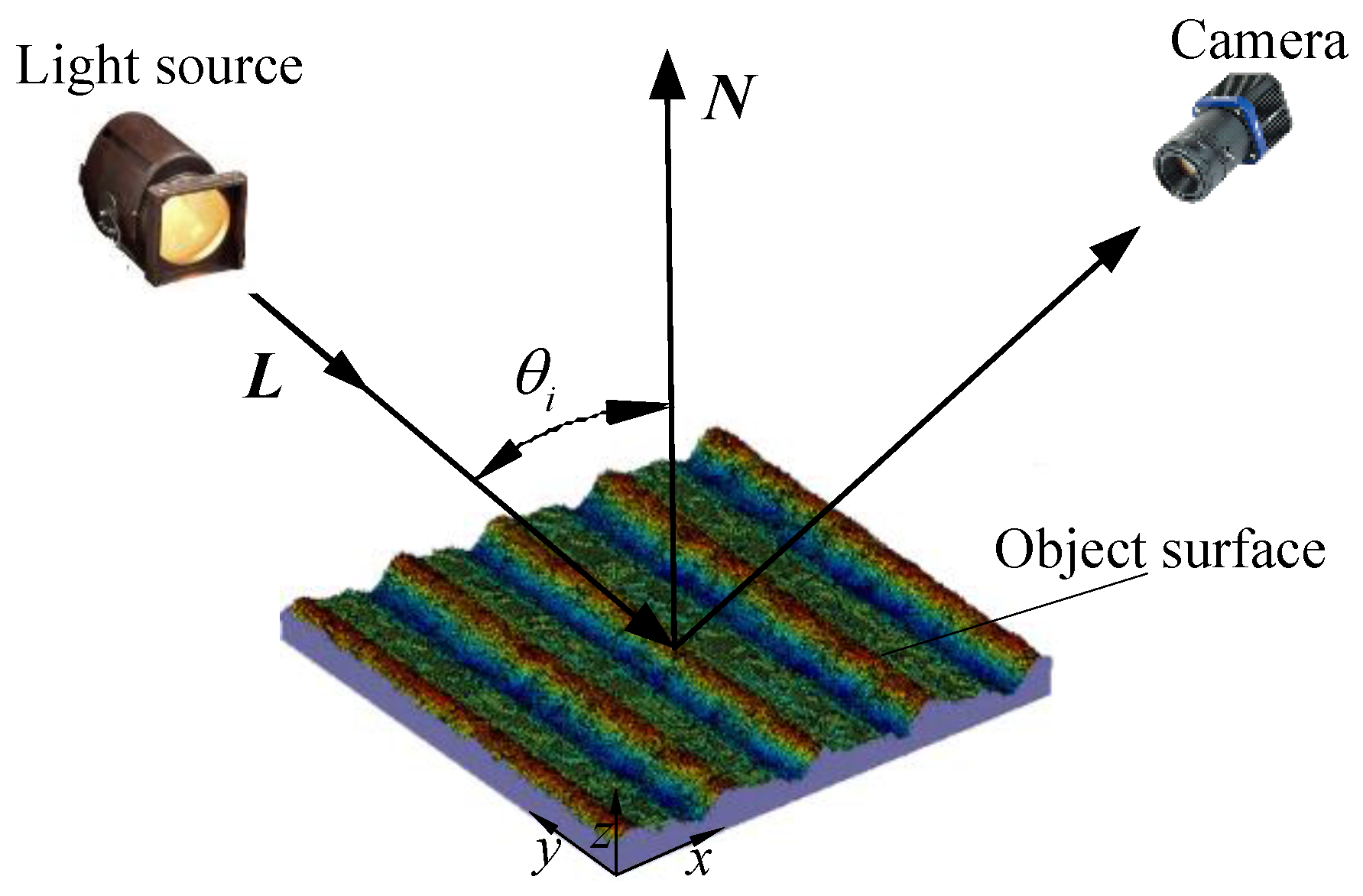
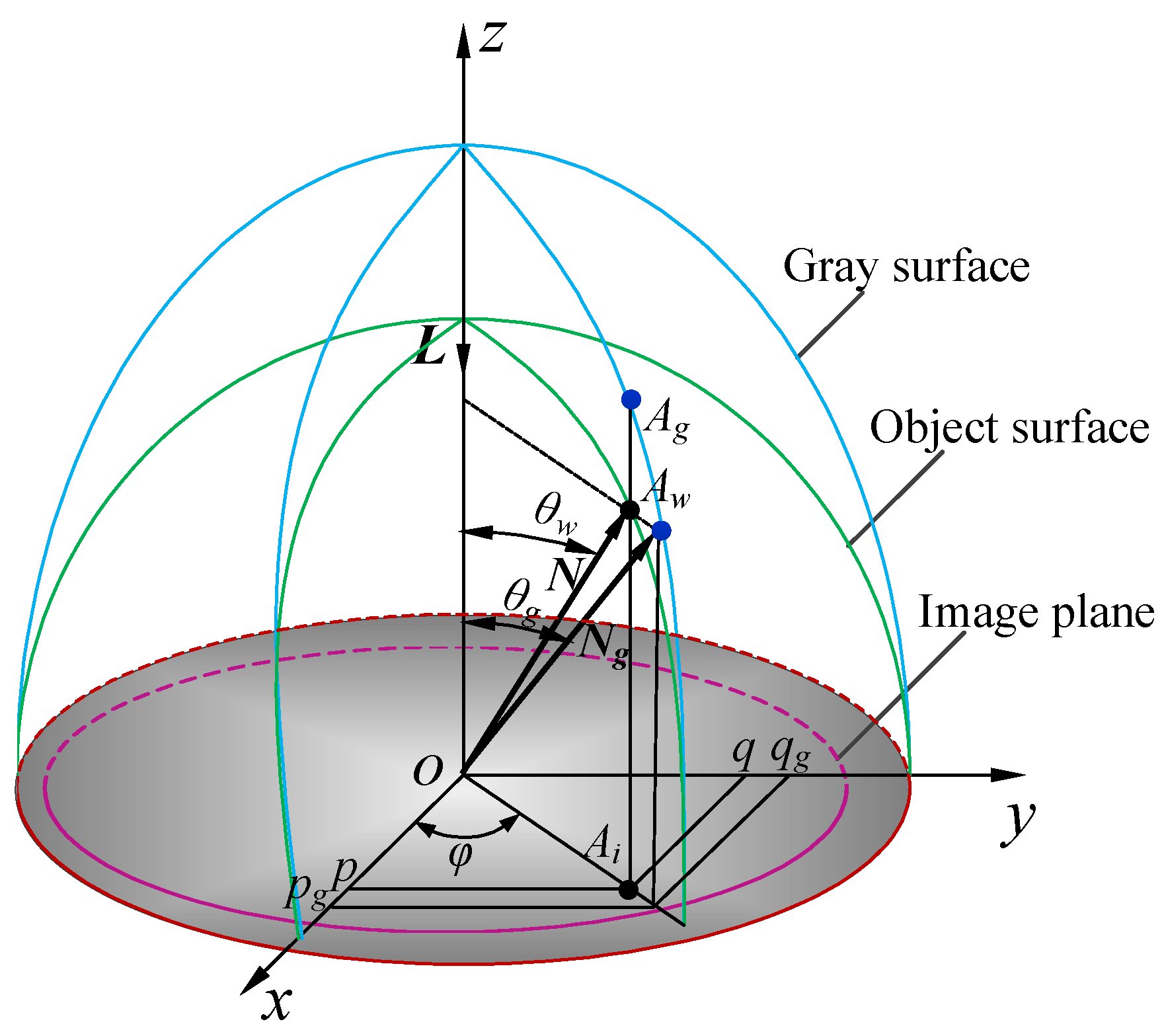
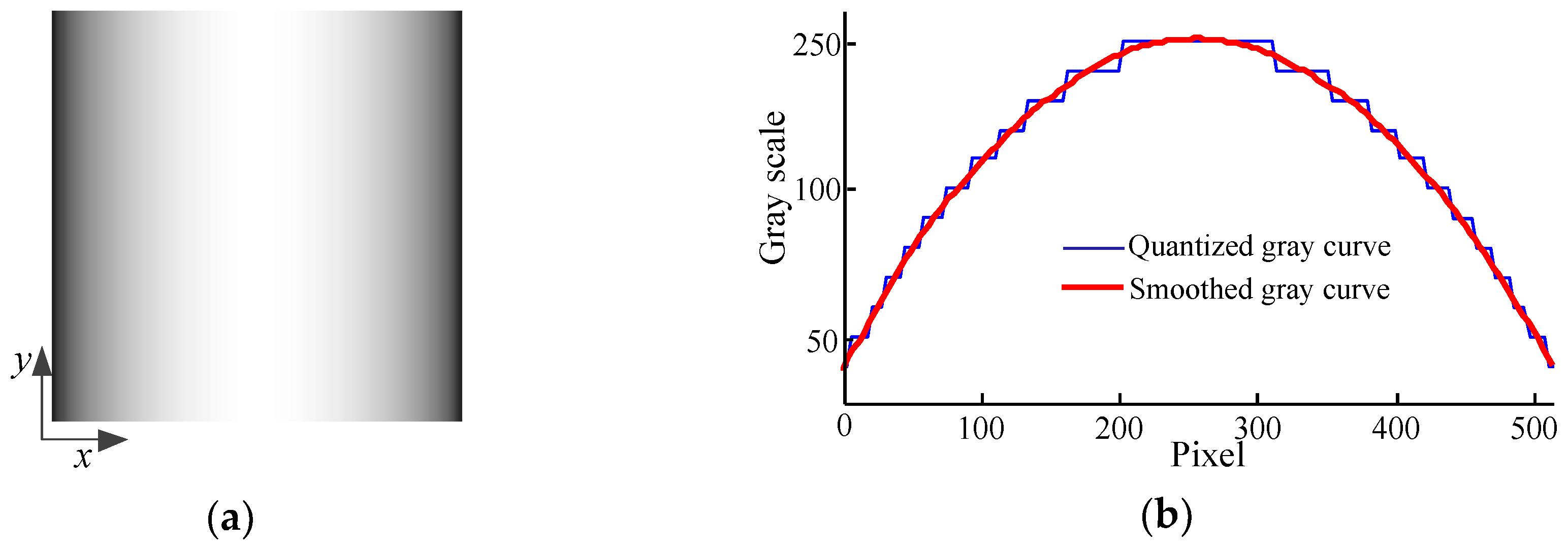
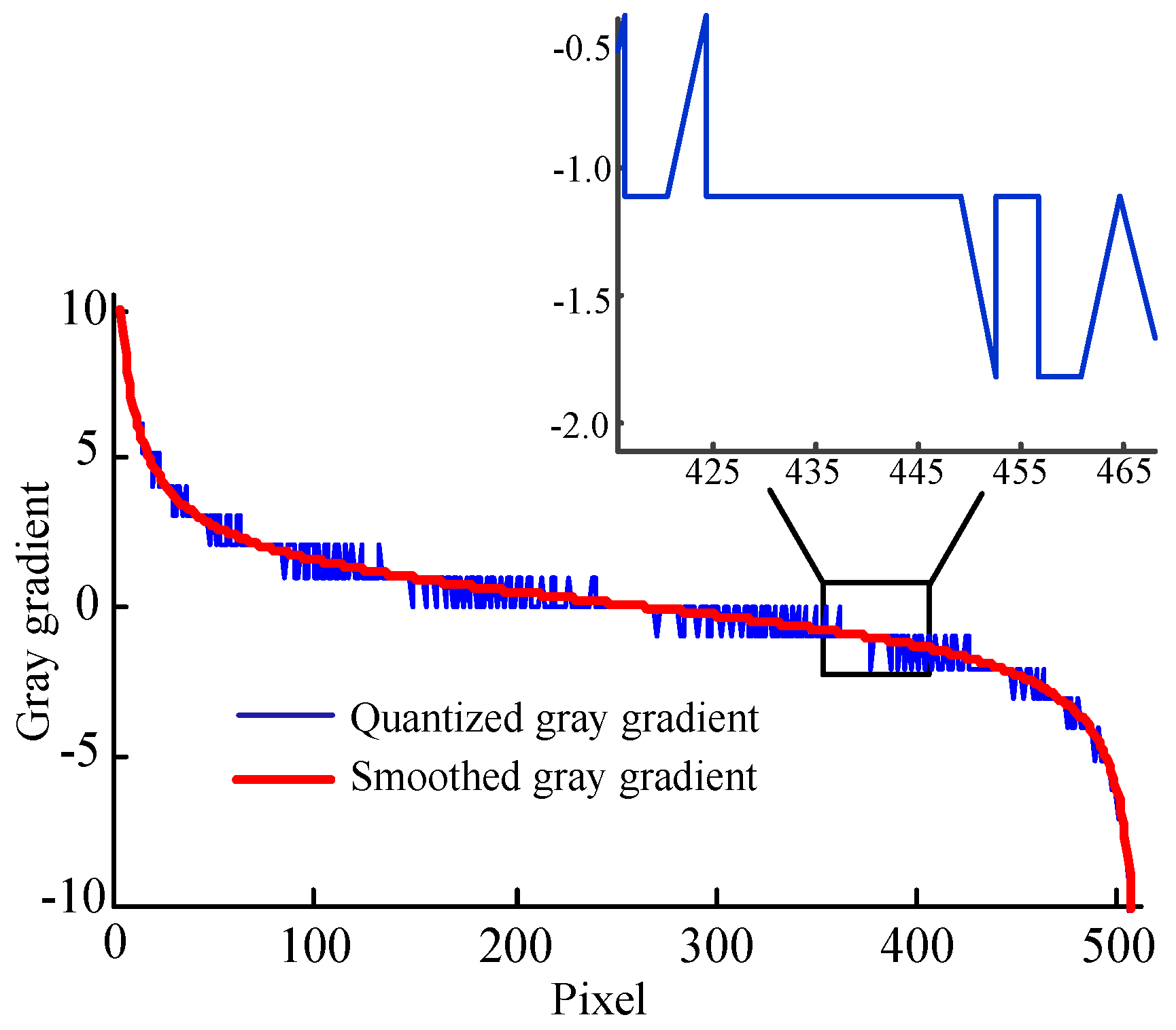
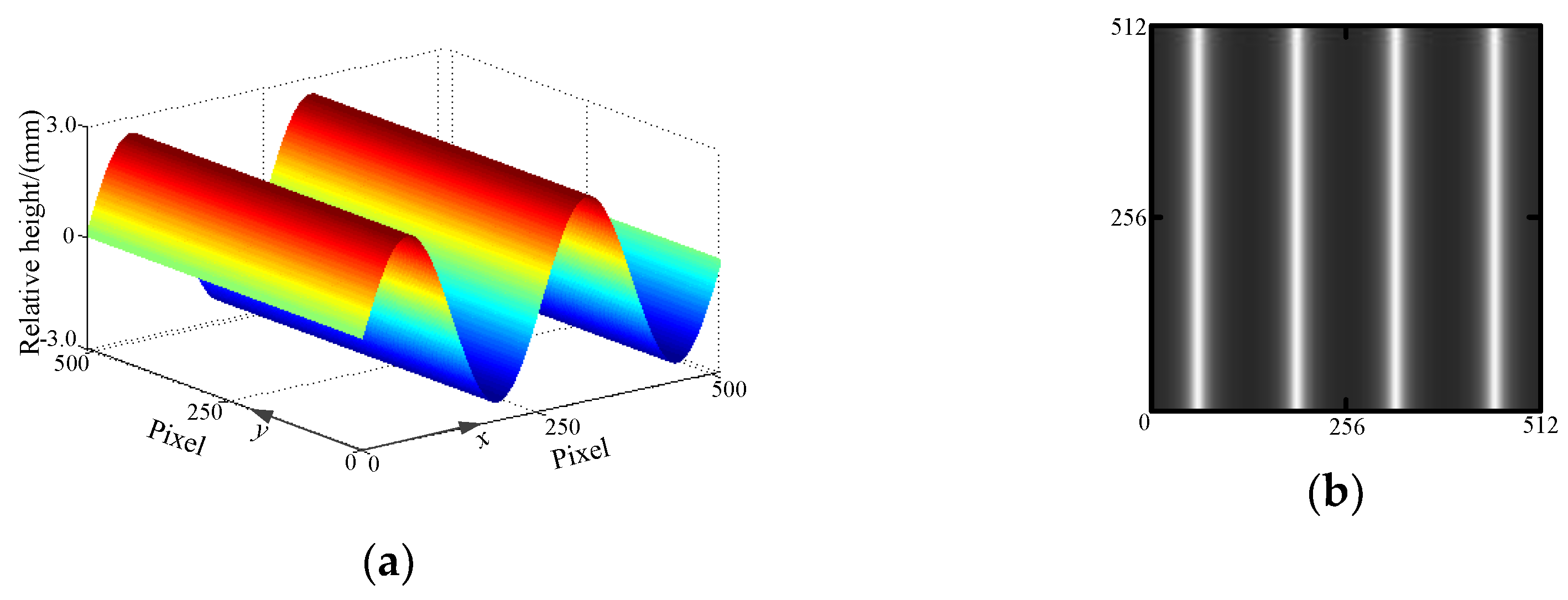
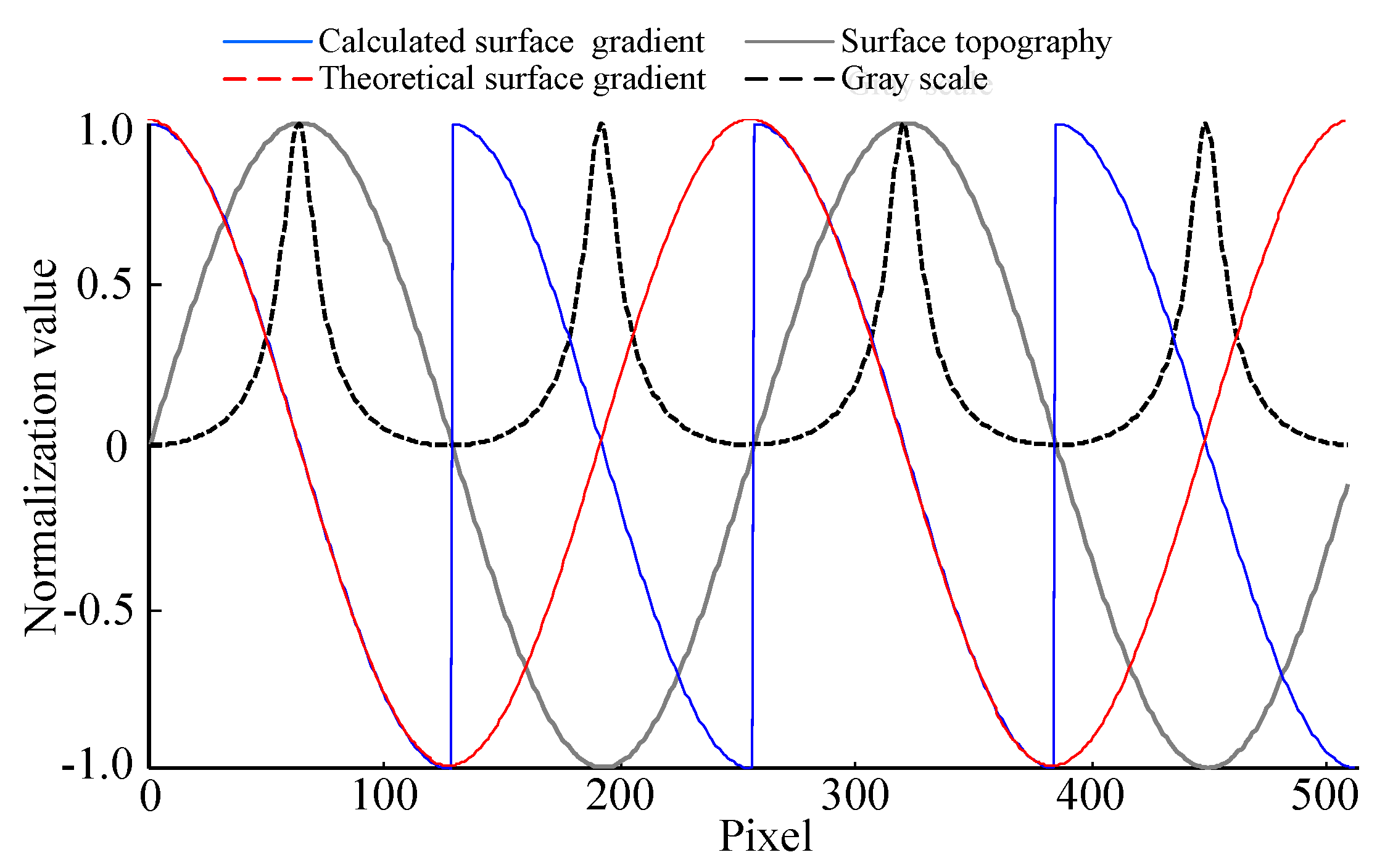

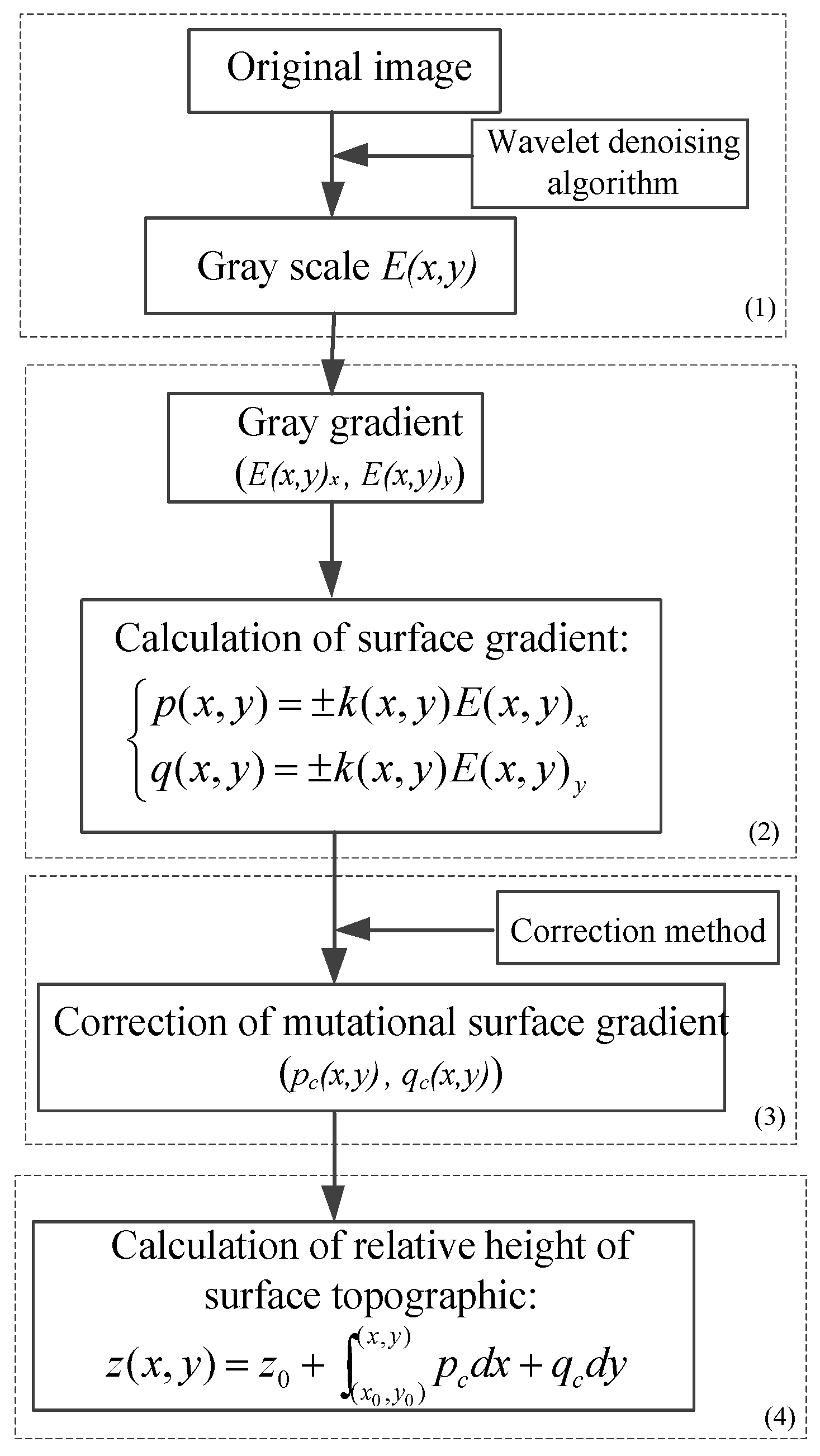
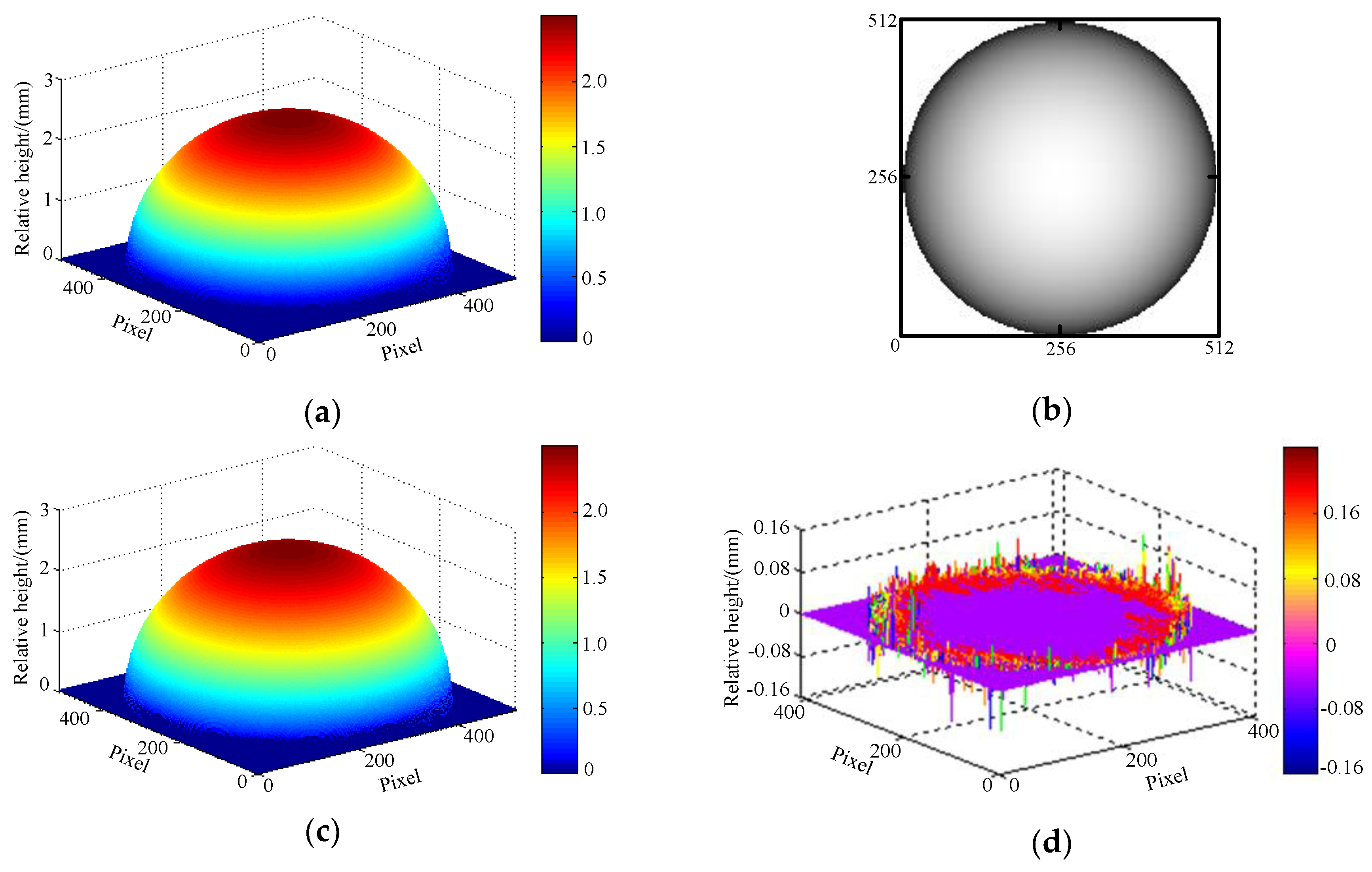
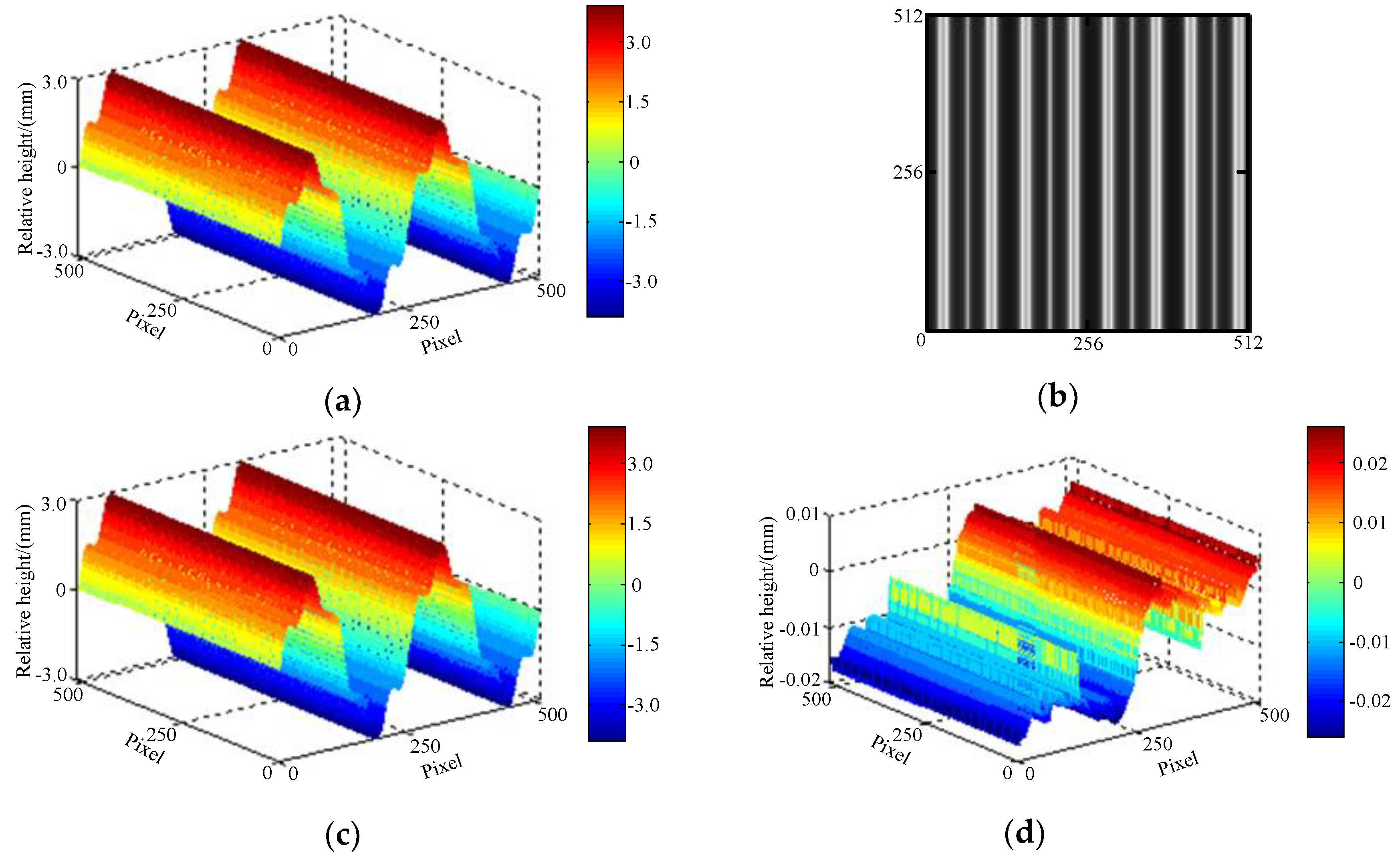
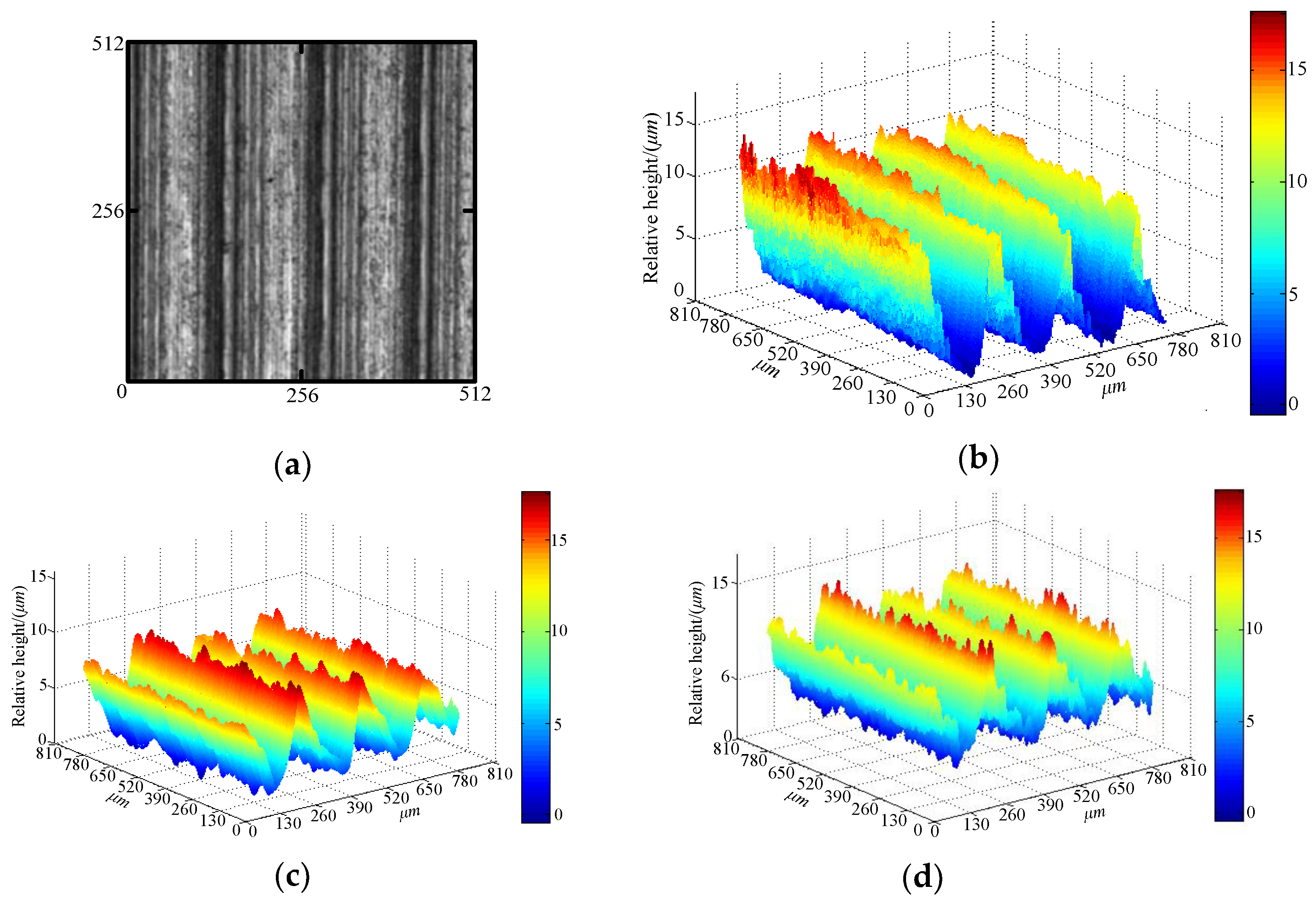


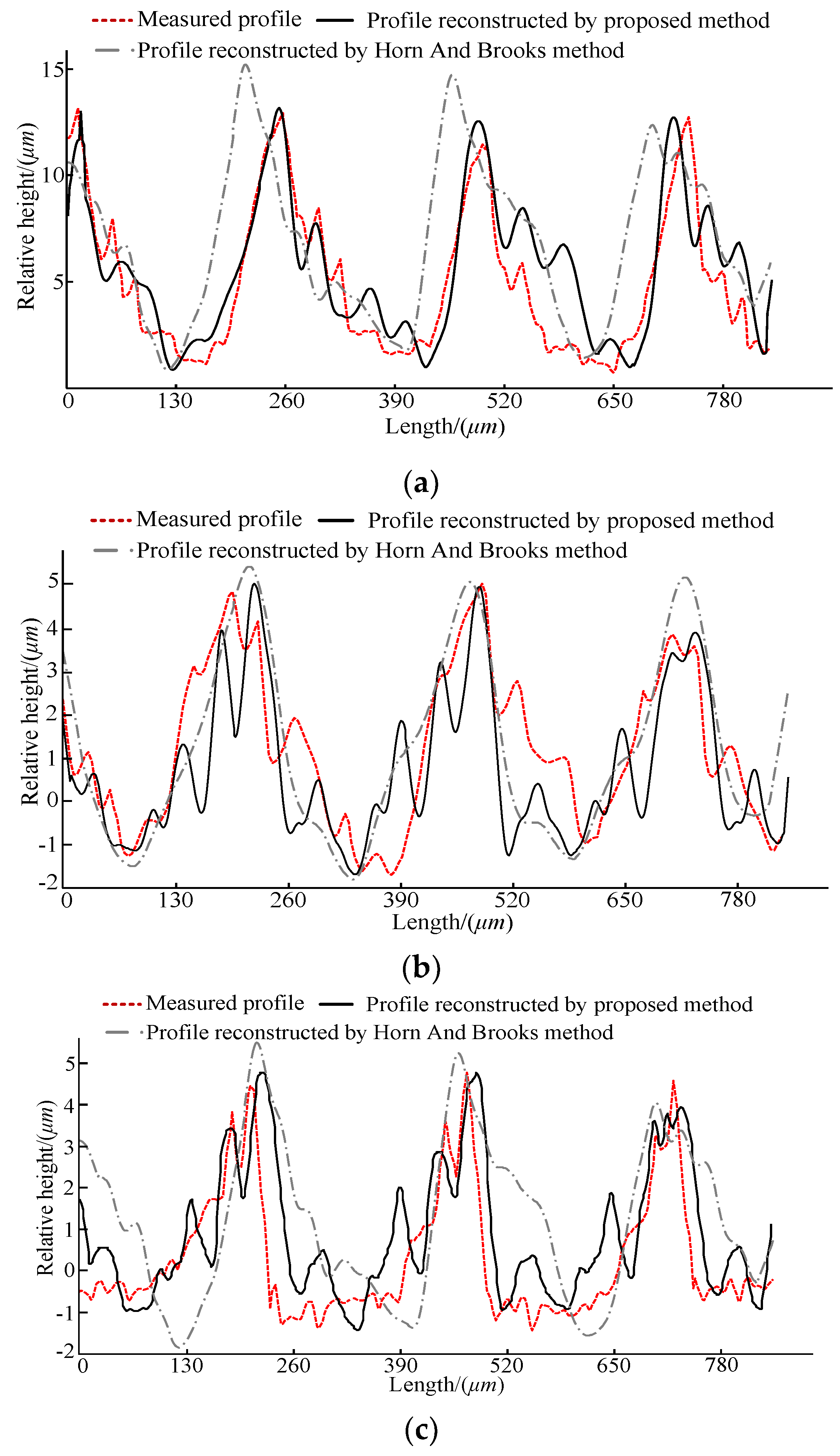
| Synthetic Image | MAE | RMSE |
|---|---|---|
| Semi-spherical | 0.087 | 0.982 |
| Sinusoidal | 0.013 | 0.965 |
| Turing Surface | Milling Surface | Boring Surface | |||||||
|---|---|---|---|---|---|---|---|---|---|
| Ra (µm) | Rz (µm) | Rq (µm) | Ra (µm) | Rz (µm) | Rq (µm) | Ra (µm) | Rz (µm) | Rq (µm) | |
| Measured data | 3.331 | 13.325 | 3.642 | 1.746 | 6.984 | 1.972 | 1.691 | 6.765 | 1.886 |
| Reconstructed data | 3.525 | 13.621 | 3.924 | 1.820 | 7.121 | 2.091 | 1.743 | 6.893 | 1.998 |
| Relative error (%) | 5.5 | 2.17 | 7.18 | 4.06 | 1.92 | 5.69 | 2.98 | 1.85 | 5.6 |
© 2019 by the authors. Licensee MDPI, Basel, Switzerland. This article is an open access article distributed under the terms and conditions of the Creative Commons Attribution (CC BY) license (http://creativecommons.org/licenses/by/4.0/).
Share and Cite
Shi, W.-C.; Zheng, J.-M.; Li, Y.; Li, X.-B. Three-Dimensional Reconstruction Method for Machined Surface Topography Based on Gray Gradient Constraints. Appl. Sci. 2019, 9, 591. https://doi.org/10.3390/app9030591
Shi W-C, Zheng J-M, Li Y, Li X-B. Three-Dimensional Reconstruction Method for Machined Surface Topography Based on Gray Gradient Constraints. Applied Sciences. 2019; 9(3):591. https://doi.org/10.3390/app9030591
Chicago/Turabian StyleShi, Wei-Chao, Jian-Ming Zheng, Yan Li, and Xu-Bo Li. 2019. "Three-Dimensional Reconstruction Method for Machined Surface Topography Based on Gray Gradient Constraints" Applied Sciences 9, no. 3: 591. https://doi.org/10.3390/app9030591
APA StyleShi, W.-C., Zheng, J.-M., Li, Y., & Li, X.-B. (2019). Three-Dimensional Reconstruction Method for Machined Surface Topography Based on Gray Gradient Constraints. Applied Sciences, 9(3), 591. https://doi.org/10.3390/app9030591






